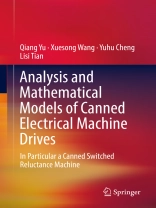This book focuses on the electromagnetic and thermal modeling and analysis of electrical machines, especially canned electrical machines for hydraulic pump applications. It addresses both the principles and engineering practice, with more weight placed on mathematical modeling and theoretical analysis. This is achieved by providing in-depth studies on a number of major topics such as: can shield effect analysis, machine geometry optimization, control analysis, thermal and electromagnetic network models, magneto motive force modeling, and spatial magnetic field modeling. For the can shield effect analysis, several cases are studied in detail, including classical canned induction machines, as well as state-of-the-art canned permanent magnet machines and switched reluctance machines.
The comprehensive and systematic treatment of the can effect for canned electrical machines is one of the major features of this book, which is particularly suited for readers who areinterested in learning about electrical machines, especially for hydraulic pumping, deep-sea exploration, mining and the nuclear power industry. The book offers a valuable resource for researchers, engineers, and graduate students in the fields of electrical machines, magnetic and thermal engineering, etc.
Mục lục
Introduction.- Electromagnetic Analysis of the Saliency and Can Effect by Network Models.- Electromagnetic Analysis of Can Effect of a Canned Switched Reluctance Machine by FE Method.- An Analytical Model of Concentric Layer Structure for Canned Machines, Part I: Modeling of Armature Coils.- An Analytical Model of Concentric Layer Structure for Canned Machines, Part II: Modeling of Magnetic Field.- An Improved Thermal Network and Electro-thermal Coupled Analysis for Canned Electrical Machines.- Conclusions and Future Work.- Appendix.
Giới thiệu về tác giả
Qiang Yu received his Ph.D. degree from University of Bundeswehr Muenchen, Munich, Germany in 2012. From 2008-2012 he was an engineer in FEAAM Gmb H, Neubiberg, Germany, where he hosted the project “design and analysis of high efficient canned switched reluctance machine drives for hydraulic pump drives”, with KSB Aktiengesellschaft, Frankental, Germany. From 2013-2014 he was a postdoctoral research associate at Automotive Resource Center, Mc Master University, Ontario, Canada, where he hosted the project “high efficient rare-earth free machine drives”. From 2014-2015 he was a postdoctoral research fellow in Universite Libre de Bruxelles, Brussels, Belgium, with a European funded project “De Mo Test EV” (Design, Modeling and Test of Electrical Vehicles). Currently he is an associate professor in School of Electrical and Power Engineering, China University of Mining and Technology. His main research interests include electromagnetic and thermal analysis of electrical machines, cannedmachine drives and mathematical modeling of electrical machines.
Xuesong Wang received her Ph.D. degree from China University of Mining and Technology in 2002. She is currently a professor in School of Information and Control Engineering, China University of Mining and Technology. Her main research interest includes electrical drives, bioinformatics, and artificial intelligence. In 2008, she was the recipient of the New Century Excellent Talents in University from the Ministry of Education of China.
Yuhu Cheng received his Ph.D. degree from the Institute of Automation, Chinese Academy of Sciences in 2005. He is currently a professor in School of Information and Control Engineering, China University of Mining and Technology. His main research interest includes electrical drives and intelligent systems. In 2010, he was the recipient of the New Century Excellent Talents in University from the Ministry of Education of China.
Lisi Tian received his Ph.D. degree from Huazhong University of Science and Technology (HUST), China in 2015. He is currently with the School of Electrical and Power Engineering, China University of Mining and Technology. His main research interests include power electronics, electrical drives and fault diagnosis.












